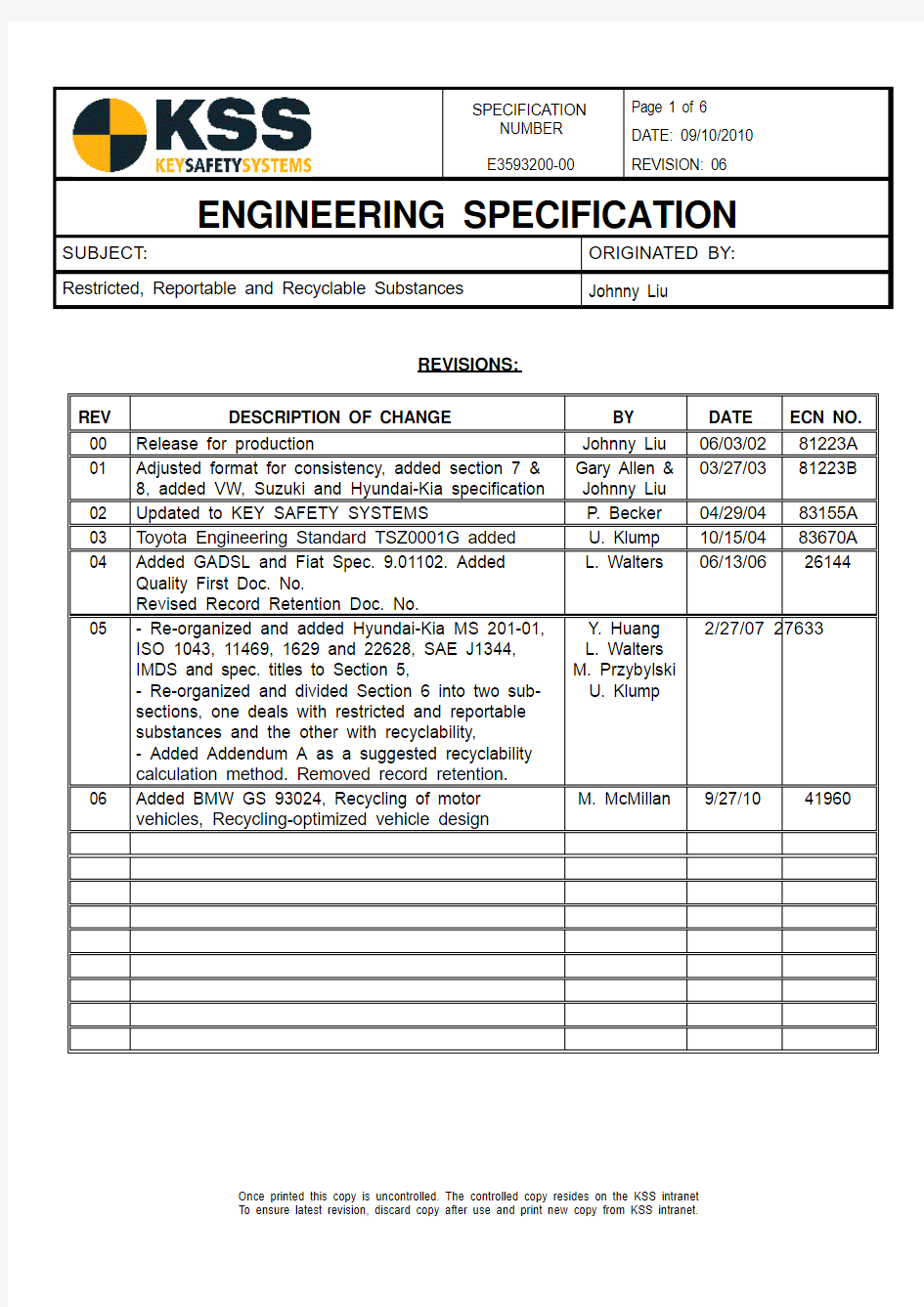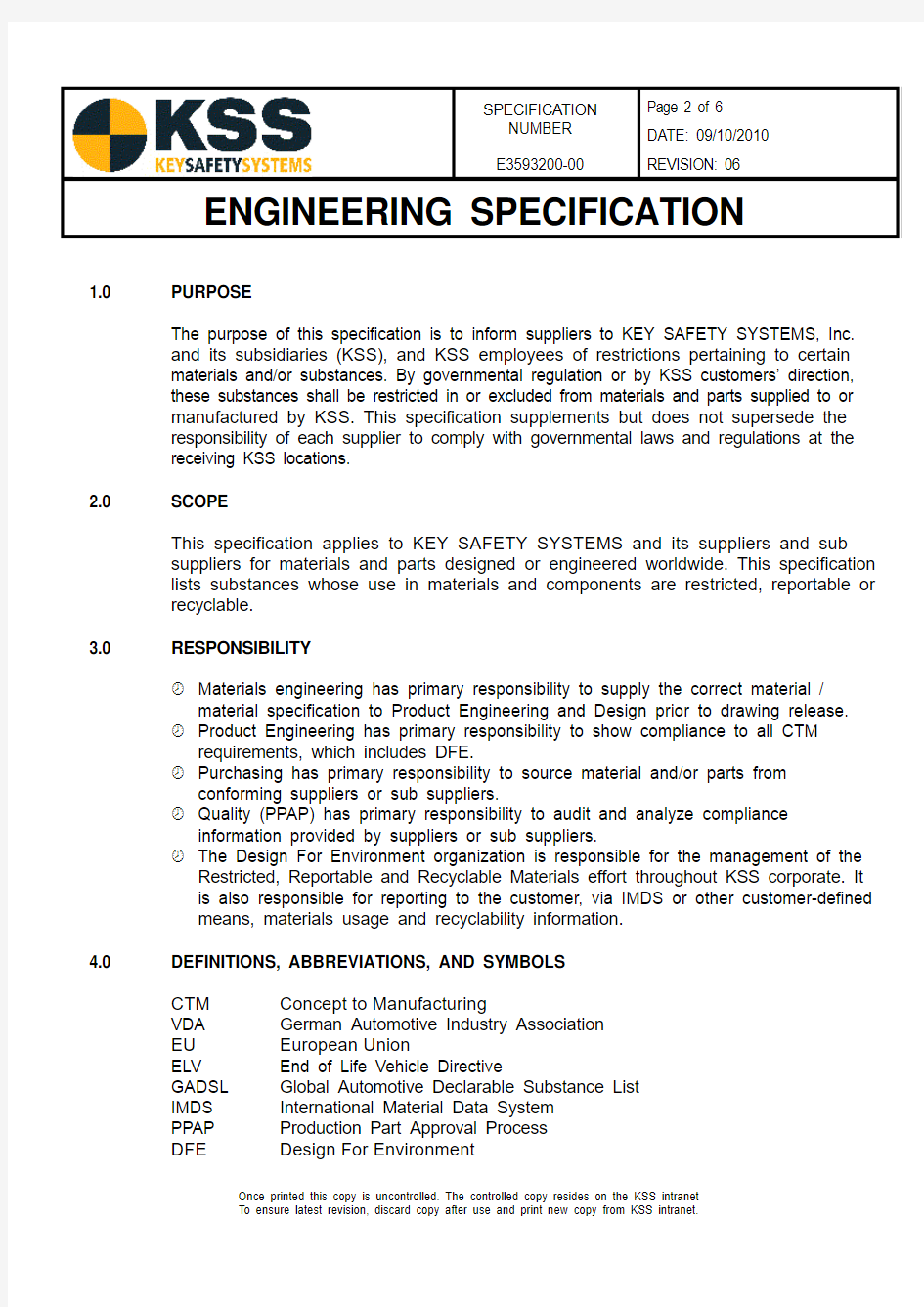E35932_06


E3593200-00
REVISION: 06
ENGINEERING SPECIFICATION
SUBJECT:
ORIGINATED BY: Restricted, Reportable and Recyclable Substances Johnny Liu
REVISIONS:
REV DESCRIPTION OF CHANGE
BY DATE ECN NO. 00 Release for production
Johnny Liu 06/03/02 81223A 01 Adjusted format for consistency, added section 7 & 8, added VW, Suzuki and Hyundai-Kia specification Gary Allen & Johnny Liu 03/27/03
81223B 02 Updated to KEY SAFETY SYSTEMS
P. Becker 04/29/04 83155A 03 Toyota Engineering Standard TSZ0001G added U. Klump 10/15/04 83670A 04
Added GADSL and Fiat Spec. 9.01102. Added Quality First Doc. No.
Revised Record Retention Doc. No.
L. Walters
06/13/06
26144
05
- Re-organized and added Hyundai-Kia MS 201-01, ISO 1043, 11469, 1629 and 22628, SAE J1344, IMDS and spec. titles to Section 5,
- Re-organized and divided Section 6 into two sub-sections, one deals with restricted and reportable substances and the other with recyclability,
- Added Addendum A as a suggested recyclability calculation method. Removed record retention. Y. Huang L. Walters M. Przybylski U. Klump
2/27/07 27633
06 Added BMW GS 93024, Recycling of motor vehicles, Recycling-optimized vehicle design M. McMillan
9/27/10
41960
E3593200-00
REVISION: 06
ENGINEERING SPECIFICATION
1.0 PURPOSE
The purpose of this specification is to inform suppliers to KEY SAFETY SYSTEMS, Inc. and its subsidiaries (KSS), and KSS employees of restrictions pertaining to certain materials and/or substances. By governmental regulation or by KSS customers’ direction, these substances shall be restricted in or excluded from materials and parts supplied to or manufactured by KSS. This specification supplements but does not supersede the responsibility of each supplier to comply with governmental laws and regulations at the receiving KSS locations.
2.0
SCOPE
This specification applies to KEY SAFETY SYSTEMS and its suppliers and sub suppliers for materials and parts designed or engineered worldwide. This specification lists substances whose use in materials and components are restricted, reportable or recyclable.
3.0 RESPONSIBILITY
? Materials engineering has primary responsibility to supply the correct material / material specification to Product Engineering and Design prior to drawing release. ? Product Engineering has primary responsibility to show compliance to all CTM requirements, which includes DFE.
? Purchasing has primary responsibility to source material and/or parts from conforming suppliers or sub suppliers.
? Quality (PPAP) has primary responsibility to audit and analyze compliance information provided by suppliers or sub suppliers.
? The Design For Environment organization is responsible for the management of the Restricted, Reportable and Recyclable Materials effort throughout KSS corporate. It is also responsible for reporting to the customer, via IMDS or other customer-defined means, materials usage and recyclability information.
4.0 DEFINITIONS, ABBREVIATIONS, AND SYMBOLS
CTM Concept to Manufacturing
VDA German Automotive Industry Association EU European Union
ELV End of Life Vehicle Directive
GADSL Global Automotive Declarable Substance List IMDS International Material Data System PPAP Production Part Approval Process DFE
Design For Environment
E3593200-00
REVISION: 06
ENGINEERING SPECIFICATION
5.0 RELATED DOCUMENTS
? 2000/53/EC, Directive on end-of-life vehicles and the most current version of the ELV Annex II
? 2003/138/EC, Component and material coding standards for vehicles pursuant to Directive 2000/53/EC
? 76/769/EEC, Restrictions on the marketing and use of certain dangerous substances and preparations
? GADSL, Global Automotive Declarable Substance List, https://www.360docs.net/doc/086689448.html, ? International Material Data System (IMDS), https://www.360docs.net/doc/086689448.html,/index.jsp ? ISO 1043, Plastics - Symbols And Abbreviated Terms
Part1: Basic Polymers And Their Special Characteristics Part 2: Filler And Reinforcing Materials Part 3: Plasticizers
Part 4: Flame Retardants
? ISO 1629, Rubbers and Latices - Nomenclature
? ISO 11469, Plastics - Generic Identification And Marking Of Plastics Products ? ISO18064, Thermoplastic elastomers – Nomenclature and abbreviated terms ? ISO 14001, Environmental Management Systems - Requirements With Guidance For Use
? ISO 22628, Road Vehicles - Recyclability And Recoverability - Calculation Method ? SAE J1344, Marking Of Plastic Parts
? VDA 231-106, Material Classification in Automobile Engineering – Structure and Nomenclature
? VDA 232-101, List of Declarable Materials in Automotive Manufacturing – Substances in Components and Construction Materials ? VDA 260, Marking of Construction Units of Motor Vehicles
? Daimler Chrysler CS-9003, Environmental, Health, and Occupational Safety Requirements for Regulated Substances or Processes and Product Recycling Reporting Requirements
? Fiat 9.01102, Quality of Supplies, Annex CK “Forbidden/limited Substances or To Be Monitored in the Finished Direct Material”
? Ford WSS-M99P9999-A1, Restricted Substance Management Standard Reporting Requirements and Guidelines
? GM GMW3059, Restricted and Reportable Substances for Parts ? Hyundai-Kia MS 201-01, Marking Of Materials For Automotive Parts
? Hyundai-Kia MS 201-02, Prohibition Of Use Of Heavy Metal For Automotive Parts ? Suzuki SES N2402, Standard for Restricting Use of Environmental Loading Substances
? Toyota TSZ0001G, Control Rules for Substances of Environmental Concern
E3593200-00
REVISION: 06
ENGINEERING SPECIFICATION
? VW 911 01, Vehicle Environmental Standard - Vehicle Parts, Materials, Operating Fluids - Avoidance of hazardous substances
? BMW GS 93024, Recycling of motor vehicles, Recycling-optimized vehicle design
6.0 REQUIREMENTS
KEY SAFETY SYSTEMS adopts standards and practices of governmental directives,
industrial associations, and its customers regarding Restricted, Reportable and Recyclable Substance specifications. 6.1 Restricted and Reportable Substances
The restricted and reportable substances are described in EU ELV Directive, GADSL, IMDS, as well as the individual OEM specifications, such as GMW3059. The OEM-specific
restricted and reportable substance requirements and reporting procedure shall always be followed. If it is not specified by an OEM specification, the commonly accepted procedures and practices outlined in GADSL and IMDS should be used. The documents associated with restricted and reportable substances are listed in table 1.
Table 1. Specifications Concerning Restricted and Reportable Substances
Organization Specification and Resources EU EU ELV Directive GADSL https://www.360docs.net/doc/086689448.html, IMDS https://www.360docs.net/doc/086689448.html,/index.jsp
VDA VDA 232 Daimler Chrysler, subsidiaries, affiliates & joint ventures CS-9003 Fiat 9.01102, Annex CK Ford, subsidiaries, affiliates & joint ventures
WSS-M99P9999-A1 GM, subsidiaries, affiliates & joint ventures
GMW3059 Hyundai-Kia MS 201-02 Suzuki SES N2402 Toyota TSZ0001G VW VW 911 01 BMW GS 93024 6.2 Recyclable Substance
E3593200-00
REVISION: 06
ENGINEERING SPECIFICATION
The standards concerning polymeric materials are listed in Table 2. If not specified in an OEM specification, the marking methods outlined in ISO or SAE standards should be used.
Table 2. Specifications Concerning Recyclable Substances
Organization Specification and Resources EU EU ELV Directive
ISO 1043 and 11469 SAE J1344 Daimler Chrysler, subsidiaries, affiliates & joint ventures
CS-9003 Ford, subsidiaries, affiliates & joint ventures WSS-M99P9999-A1
Hyundai-Kia MS 201-01
Metallic materials are usually readily recyclable and are not covered in this section.
In the event that a customer requires the recyclability rate for a system or sub-system, a recyclability calculation method based upon ISO 22628 is provided in Appendix A. The calculated recyclability rate will be reported in and be part of DFE or PPAP document.
7.0 NON-COMPLIANCE
In rare cases, there may be a need to grant a supplier a deviation from the above requirements. If a deviation is necessary, suppliers must follow the typical product deviation approval process set forth by KSS’s Quality First Manual (Doc #82000030). Such deviations will be granted on a case-by-case basis and will be limited to only extraordinary circumstances.
8.0 PRODUCTION PART APPROVAL PROCESS
KSS’s PPAP process has been modified to include a Design for Environment requirement. In order to comply, suppliers must complete KSS’s Restricted Materials and Recyclability Reporting Certification (KSS Document # 82000482), submit it to the DFE organization and then include the approved certification in their PPAP submission. All documents relating to the DFE PPAP requirement are available on KSS’s Internet site (https://www.360docs.net/doc/086689448.html,) under “Supplier Info/ Design for Environment”.
E3593200-00
REVISION: 06
ENGINEERING SPECIFICATION
APPENDIX A
The recyclability calculation of a system or sub-system can be estimated using the following formula:
Recyclability Rate R cyc = (m Plastic + m Metal + m Other ) / m SYS * 100
Where,
m Plastic – the total weight of all recyclable plastic parts in the system m Metal – the total weight of all metallic parts in the system
m Other – the total weight of all other recyclable materials (e.g. paper) m SYS – the total weight of the system or sub-system
